Tarikhaneh Mosque | The 2nd Oldest Mosque in Iran
Damghan, an ancient city, is home to numerous historic sites. Among these is the Tarikhaneh Mosque, a significant example of early Islamic architecture within Iran. Situated southeast of Damghan, this mosque is recognized as one of the country's oldest post-Islamic structures.
Architecturally, the Tarikhaneh Mosque represents a prime example of early Islamic mosque design in Iran. While the Jameh Mosque of Fahraj in Yazd is considered Iran's oldest mosque, the Tarikhaneh Mosque holds the distinction of being the second oldest.
The History of Tarikhaneh Mosque
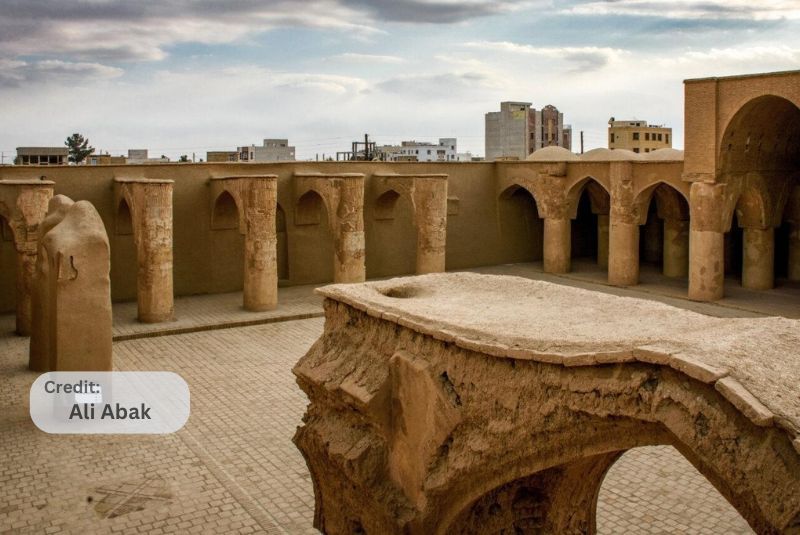
Before the Arab conquest of Iran, the site where Tarikhaneh Mosque stands was originally a sacred place housing a Zoroastrian fire temple. During the construction of the mosque, remnants of this fire temple were incorporated into the new structure to conserve resources, time, and effort. Only necessary modifications were made to adapt the existing elements to the mosque's design.
The name "Tarikhaneh" is derived from the combination of the words "Tari," meaning fire, and "khaneh," meaning house. The mosque's historical name reflects its connection to the former fire temple that once occupied the site.
Additionally, the mosque is sometimes referred to as the Chehelsetun Mosque. In historical texts, the term "Chehelsetun" was often used for structures with numerous columns. The name "Forty Column Mosque" does not imply that the building literally has forty columns; rather, it refers to the abundance of columns within the structure.
The construction of the original mosque building dates back to the mid-8th century CE, between 130 and 170 AH, during the transition from the Umayyad to the Abbasid rule. The mosque's layout follows the architectural style commonly seen in mosques from the Umayyad period. However, the materials and construction techniques are reminiscent of the Sassanid era, with brickwork similar to that of the Parthian period.
Throughout history, Tarikhaneh Mosque has served as a significant religious and cultural center in Damghan. It remains an important part of Iran's cultural heritage, offering visitors a unique atmosphere filled with a sense of mystery and tranquility.
Tarikhaneh Architecture
The first significant restoration of the Tarikhaneh Mosque occurred during the 13th century CE (7th century AH) and is recognized as a prime example of Seljuk architecture. During this period, the original dome, which was built on four pillars and reflected Sassanid design, was meticulously restored. Later, during the Ilkhanid era, the mosque underwent further renovation, which included the addition of porches and stucco decorations that enhanced its visual appeal. Archaeological findings suggest that during the Safavid period, the mosque was used as the Grand Mosque of Damghan. The minaret, a prominent feature of the mosque, was constructed during this time and adorned with intricate tile work, making it a masterpiece of Safavid architecture. Over the centuries, the mosque has been renovated multiple times, from the early Islamic period through the Qajar era. In 1931 (1310 AH), it was officially registered as one of Iran's national monuments.
The mosque's layout reflects the architectural style prevalent during the Umayyad period, while its construction materials and design elements are rooted in Sassanid and Parthian traditions. The mosque occupies a rectangular plot of 62 by 70 meters and is comprised of several key sections:
Courtyard (Central Courtyard)
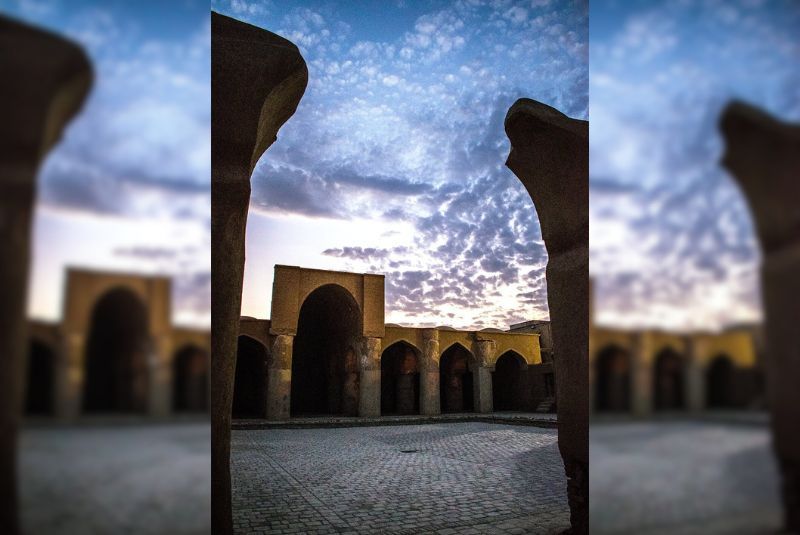
The mosque's courtyard is nearly square, measuring 27 by 27 meters, and lacks a central pond. It was originally surrounded by 22 covered porticoes with curved arches and circular columns. While some of these structures remain intact, others have suffered damage over time. The courtyard also features two entrances—one on the west side and another on the south side, connected to the mosque's basement by three stairs. Traces of four-column structures on the west, east, and north sides suggest that this section was initially roofed.
Mosque Entrances and Corridors

The original entrances to the mosque, which connected to the porticoes, have mostly been lost to time. However, architectural research indicates that there were eight entrances, three on the northwest side and five on the northeast side. An old corridor, accessible from the north through a wooden door and two wide platforms, runs along the western side of the mosque. This corridor, 20 meters long and four meters wide, connects to another corridor that leads to a newer courtyard. The minaret and these corridors are among the oldest parts of the structure. The minaret contains 105 steps, with an interior height of 31 meters and an exterior height of approximately 32 meters.
Shabestan (Prayer Hall)
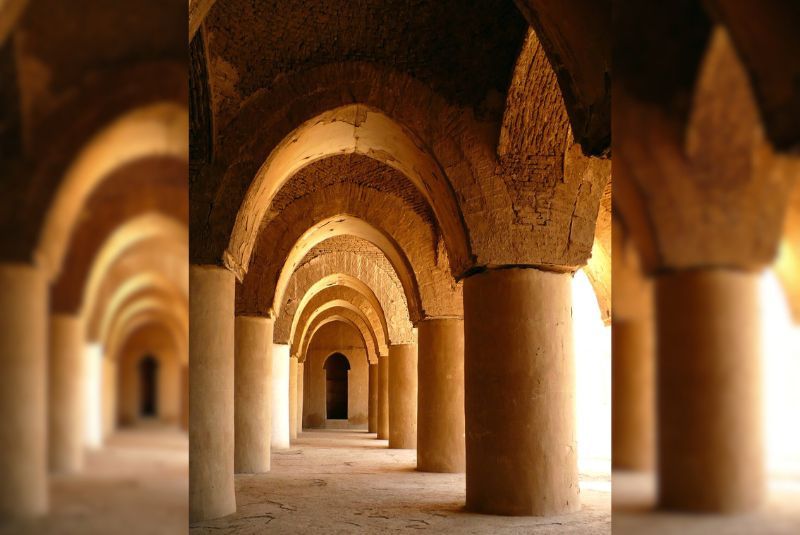
Located on the southwest side of the mosque, in the direction of Qiblah, the Shabestan is a pillared hall featuring 26 circular columns reminiscent of those found in Sassanid palaces. Eighteen of these columns are arranged in three rows of six within the hall, while the remaining eight columns are situated at the entrance. Each column, made of brick, has a diameter of 1.5 meters and a circumference of around 5 meters, with a height of approximately 3 meters up to the arches. The total height from the Shabestan floor to the roof is about 6 meters.
The Shabestan's roof is covered with brick arches, following pre-Islamic architectural traditions. The central arch is both wider and taller than the others. However, much of the original roof was destroyed in the 19th century CE (13th century AH) and later restored by Mirza Agha Ameli with the support of Damghan's residents. The restoration introduced pointed arches made of raw clay, a common method at the time, though remnants of the original arches are still visible.
Minaret
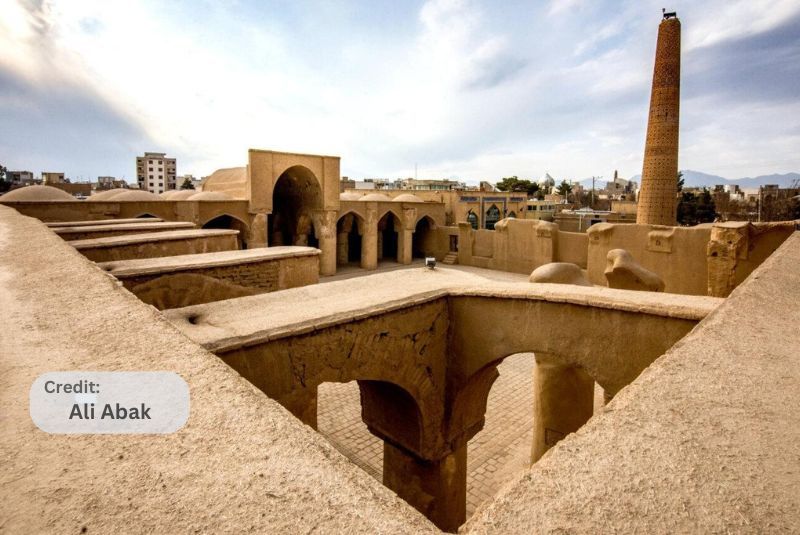
The mosque's original minaret, located on the western side, was built using mud clay, inspired by the minarets of Iraqi mosques. Early minarets in Iran were typically constructed on square or hexagonal bases, and Tarikhaneh's minaret followed this tradition with a square base measuring 6.5 square meters. Unfortunately, it was destroyed in an earthquake in the 9th century CE (241 or 242 AH). The current minaret, built in the 11th century CE (5th century AH) by Bakhtiar Abu Harb, a ruler of the Ziyarid dynasty, is constructed of brick, stands 26 meters high, and has a circular form. The minaret once reached greater heights but lost its cap due to an earthquake. The base circumference is about 13 meters, tapering to 8.5 meters at the top. Access to the upper part is via 86 interior steps, and a notable feature is a 1.5-meter-wide Kufic inscription that encircles the minaret at a height of 6 meters.
Stone and Brick Columns
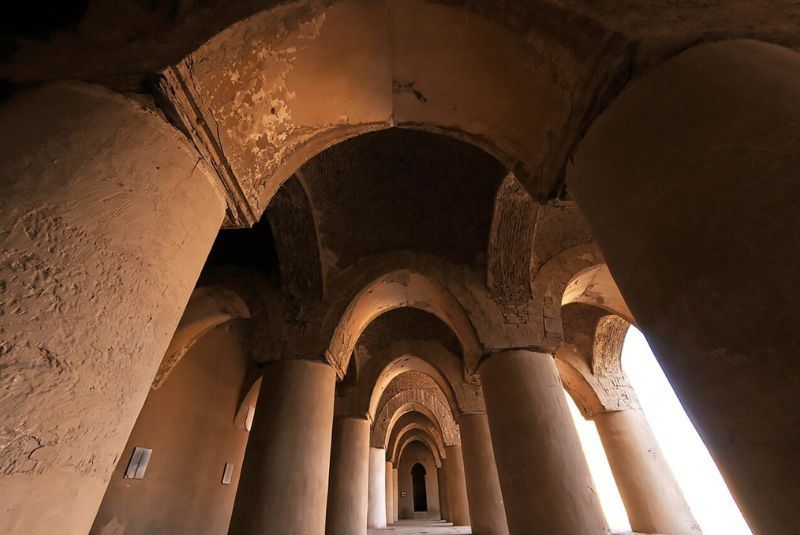
The mosque's stone pillars are reminiscent of the Sassanid era, while the brick columns added during the Seljuk period stand as enduring symbols of the mosque's long history, having withstood earthquakes, floods, and the passage of time.
Dome
The dome, constructed during the Seljuk period, is an impressive symbol of architectural stability. Some archaeologists believe that the mosque originally housed a four-arched Sassanid fire temple with a dome on top.
Porches
The mosque features two porches, located on the north and south sides, built during the Ilkhanid period. These porches offer an open, reflective space, adding to the mosque's historic character.
Plaster and Tile Decorations
The mosque is adorned with stucco and tile decorations from various periods, contributing to its unique aesthetic appeal.
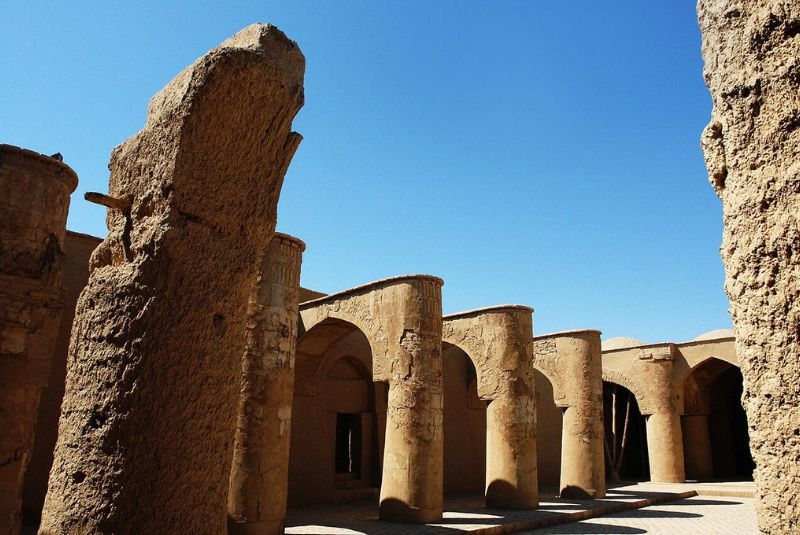
Historic Mihrab
The mosque's simple and unadorned mihrab is a symbol of spirituality and humility, reflecting the mosque's religious significance.
Central Courtyard
A key feature in traditional Iranian architecture, the central courtyard is flanked by porches on both sides.
Historical Reservoir
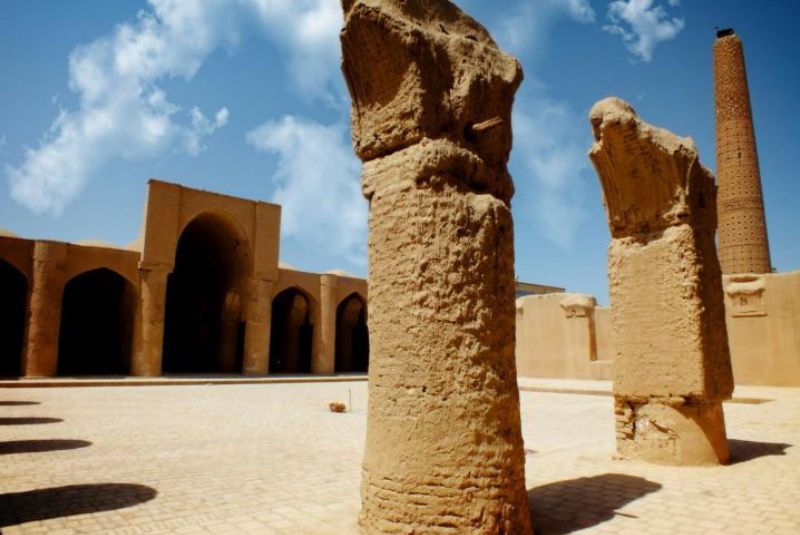
The mosque also contains a large reservoir, historically used for water storage, highlighting the foresight and planning of its original builders.
Tarikhaneh Location and Access
Tarikhaneh Mosque is one of Semnan province's notable historical landmarks, situated along Damghan Railway Station Street in the city of Damghan. Damghan, a small yet historically rich town, offers visitors a chance to explore a variety of cultural and historical sites, many of which are conveniently located near the Tarikhaneh Mosque.
Nearby Attractions
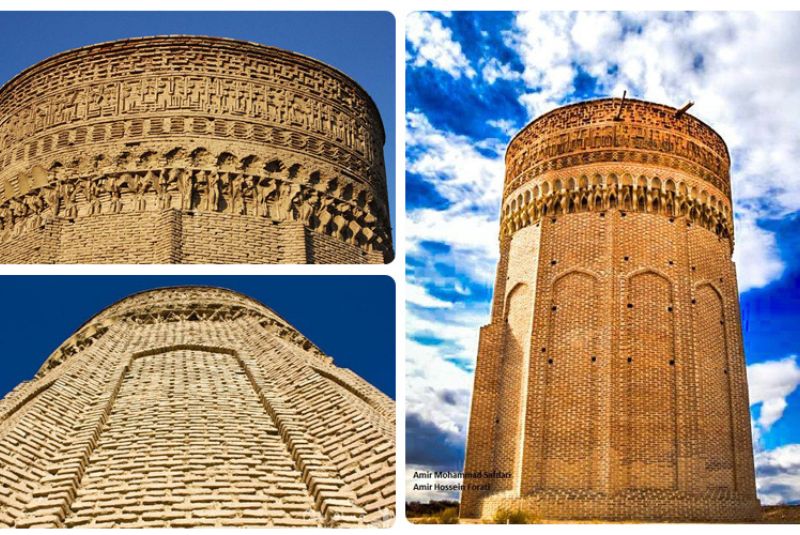
Hissar Hill & Hissar Castle: Located just a short distance from the mosque, Hissar Hill is one of Iran’s most significant ancient sites, dating back to the fifth millennium BC.
- Chehel Dokhtar Tower: This tomb tower, dating from the Seljuk period, is close to Tarikhaneh Mosque and is known for its exquisite architecture and intricate brickwork.
- Damghan Bazaar: One of the oldest markets in Iran, the Damghan Bazaar is a must-see. Historically, mosques, bazaars, and water reservoirs were built near each other, making the bazaar easily accessible from the mosque.
- Jameh Mosque of Damghan: Another historical mosque in the city, the Jameh Mosque is known for its beautiful architecture and tile work. It is located near the Tarikhaneh Mosque and is a significant tourist attraction in Damghan.
- Pir-e Alamdar Tower: This tomb, dedicated to a general of Imam Hasan, is another historical site located close to the mosque. Known as one of the best examples of tomb architecture, the Pir-e Alamdar Tower is a notable monument in Damghan.
Visitors passing through Damghan should take the time to explore these attractions, as they offer a unique glimpse into the region's rich cultural and architectural heritage.
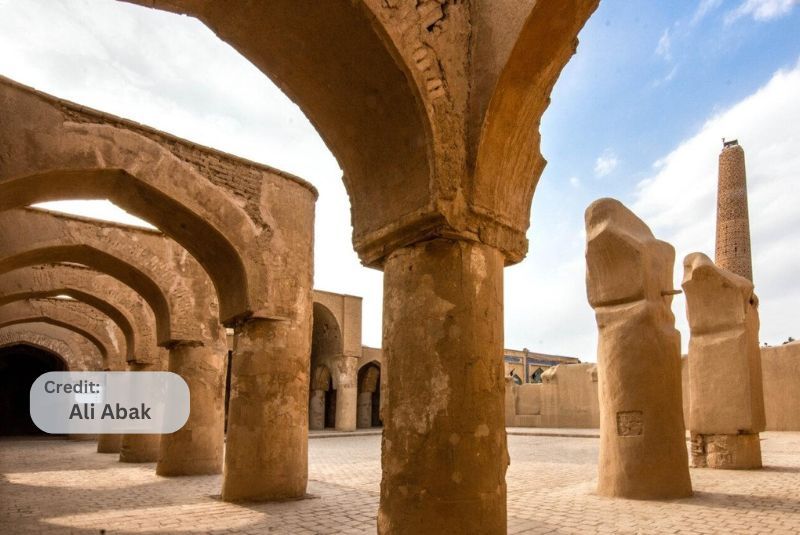
Final Takeaway
The Tarikhaneh Mosque stands as a significant monument of historical importance, offering a captivating journey through Iran's architectural evolution. This living museum showcases a harmonious blend of Islamic and pre-Islamic influences. If you find yourself exploring the enchanting city of Damghan in the Semnan province, be sure to include the Tarikhaneh Mosque in your itinerary for an unforgettable experience.
Share your story!
Comment below and let us know about your Experience.
Your story inspires others!


Comment
Leave a Comment